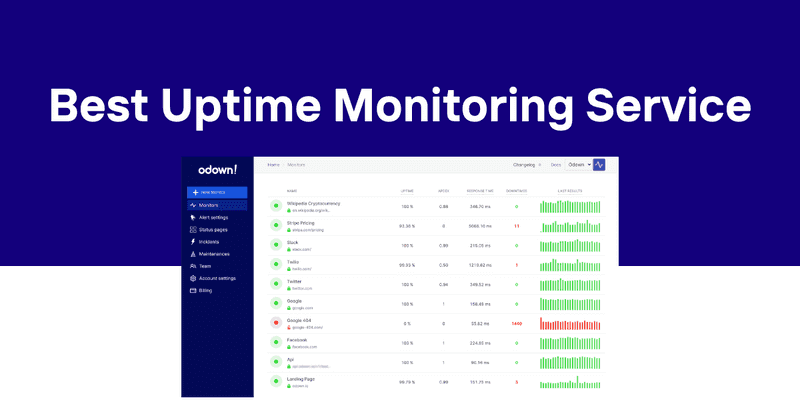Best Uptime Monitoring Service in 2024
Investing in the best uptime monitoring service is like paying for peace of mind. You can rest assured your website is running smoothly around the clock.
In the event something goes down, you’re the first to know so you can rectify the issue fast. This maintains customer trust and drives more revenue for your business. But with so many different tools at your disposal, each claiming to align with your needs, how can you determine which is truly the best website uptime monitoring solution? We’re here to help you find out.
We’ve analyzed the top 5 choices on the market based on their monitoring frequency, alert systems, global coverage, user experience, integration capabilities, reporting, pricing, and support among other features. Here are the best uptime monitoring tools in 2024:
- Odown
- Pingdom
- StatusCake
- StatusPage
- Uptime Robot
While each has its merits, only one can truly be the best. That’s Odown’s website uptime monitoring solution. It offers all the capabilities you need in one simple, affordable package - from custom alerting to integrated incident management, public status pages, SSL monitoring, and more.
Find out firsthand what makes it the #1 choice through a risk-free 14-day trial today!
Why You Need a Website Monitoring Solution
First things first - what is website monitoring, and why do you need it? This is the process of tracking your website’s performance, functionality, and availability. It’s an excellent investment for any website that generates traffic. Here’s why:
- Ensures Constant Availability: If your website ever goes down you’re the first to know so that you can get the problem fixed fast. Minimizing user downtime helps maintain service continuity and user trust.
- Optimizes User Experience: You can identify and rectify issues that could detract from the user experience by monitoring page load times and functionality. This ensures your site remains user-friendly and efficient, which is not just great for real users, but also for SEO!
- Protects Revenue: Since website performance directly impacts sales, monitoring helps safeguard against losses caused by site unavailability or poor user experience. Think about it like this - how will a user buy your product when your website is down?
- Provides Performance Insights: Gathering data on website health and user interactions offers you actionable insights to improve site performance and decision-making.
A quality website monitoring solution is a proactive way to manage your digital presence. It’s a small price to pay for the extensive benefits you’ll gain. Most notably? Peace of mind! You can rest assured your website is up and running 24/7, 365.
What Separates the Best Uptime Monitoring Service From the Rest?
Now knowing why website monitoring tools are important, what should you look for in a solution to ensure you’re getting the best of the best?
The best uptime monitoring tools are those that offer frequent checks from a number of locations, offering a comprehensive look at your website’s performance globally. They also allow you to customize your alerts, leverage advanced analytics to make optimization decisions, and are equipped with other features.
We’ll cover all this and more below to leave you feeling confident in choosing the best website uptime monitoring service for your unique needs.
Monitoring Frequency and Reliability
Your first step in vetting a service should be determining how frequently it checks the status of your site. For critical online operations, a higher frequency (like every minute) is essential to catch and address downtime immediately. On the other hand, for less critical aspects, checking every 30 minutes or hourly might suffice.
The system also has to be reliable, though, which means accurately detecting outages and performance issues without false alarms. This involves sophisticated algorithms and mechanisms to confirm incidents, distinguishing between real downtime and temporary network glitches.
This precision prevents unnecessary panic and ensures that teams can focus on genuine issues, enhancing operational efficiency and trust in the monitoring system.
Beyond how often the service checks your website, determine where it’s checking from. After all, you need to know that your website is performing well not just on the West Coast but also on the East Coast and abroad in other parts of the world.
As you look at a service’s monitoring capabilities, determine what exactly it helps you keep track of. Yes, you need the best uptime monitoring - but what about SSL monitoring, API monitoring, or other areas of your website? A versatile solution will consolidate the tools you need in your IT stack.
Alert System and Notification Process
An effective web monitoring solution won’t just identify downtime, it makes sure the people responsible for fixing the issue find out before a real user does. This is why a thorough assessment of the alerting capabilities offered is so important - it minimizes downtime as much as possible.
This system should be flexible, allowing for the customization of alert thresholds, types, and escalation policies to suit specific operational needs. You should also be able to recieve alerts however you see fit. This could include email, SMS, Slack, Telegram, and in some cases, phone.
The process should also facilitate easy integration with incident management tools, streamlining the workflow from detection to resolution and allowing teams to manage and communicate about incidents effectively.
Better yet, opt for a system that has incident management features built into the software’s interface. This brings down both the cost and complexity of your uptime monitoring solution.
Ease of Setup and Use
The best uptime monitoring tools combine powerful functionality with user-friendly design, making them accessible to both technical and non-technical users.
This dictates how quickly you can start monitoring your website after signing up for the service. Look for a seamless onboarding process, clear documentation, and the ability to easily configure monitoring settings such as URLs to monitor, check frequency, and alert conditions.
Features like drag-and-drop editors for the best status pages, simple forms for setting up checks, and intuitive dashboards for monitoring performance and analytics, enhance the user experience, making the tool more effective and less time-consuming to manage.
Reporting and Analytics
One of the primary reasons to invest in an uptime management solution is for the data you’ll gain with all this tracking. Reporting is important because it empowers you to turn raw data into actionable insights, enabling you to optimize your website accordingly.
Detailed reports should include metrics such as uptime percentages, average response times, downtime incidents, and performance by region. You should be able to drill down the data for specific time frames, locations, or events to identify patterns that require attention.
Integration with other tools, like Google Analytics or business intelligence platforms, can further streamline data collection and analysis, giving you a holistic view of the website's performance and its impact on business goals.
Price and Value for the Money
While it’s tempting to choose the cheapest option possible, you have to look beyond the initial price tag and think about the overall value you’re getting. After all, this is an investment that will deliver an ROI in the form of revenue protection.
Pricing models vary, with some services offering tiered plans based on features, frequency of checks, number of monitoring locations, and support levels. It's important to evaluate whether the cost aligns with the features and reliability of the service.
A service that may cost more upfront but offers comprehensive monitoring tools, reliable alerts, integrated incident management, and more will actually prove to be the better value in the long run.
Overview of the Best Uptime Monitoring Tools in 2024
While there’s a lot to consider in choosing the best website uptime monitoring tool, we hope our buyer’s guide leaves you with a clear understanding of the most important factors to consider. Now, we’ll highlight the top solutions on the market to point you in the right direction. We’ll start with the #1 best uptime monitoring service ever: Odown.
Odown
Our website monitoring service ensures that your online presence is perpetually protected from downtime, maintaining trust with your users and avoiding the loss of transactions.
It includes everything you need to manage uptime, from diverse monitors to customizable alerts. The best part? It costs less than the alternatives. Here are some of the things that our customers love about Odown:
- Uptime Monitoring: We guarantee real-time oversight of your website’s availability at intervals as short as one minute. This ensures no incident goes unnoticed, so you can maintain a steadfast online presence with an excellent user experience.
- Global Coverage: With data centers across the Americas and around the world, Odown’s extensive coverage ensures that you have a complete picture of your website's performance, catering to your international audience with precision and reliability.
- Integrations and Alerting: We support Slack, SMS, Email, Webhooks, Telegram, Discord, PagerDuty, Opsgenie, and Discord, which means alerts can be seamlessly integrated into your existing workflows. The right people get necessary information instantly, enabling rapid response to any detected issues. We’re constantly working on more, too, with Twitter, Microsoft Team, Google Chat, Zapioer, and Pushbullet coming soon!
- Incident Management: Efficiency in resolving outages and performance issues is crucial, and Odown's built-in incident management system streamlines this process. From identifying problems to resolving them, our system helps you minimize the impact on your services and reputation. You’ll save money on 3rd party incident management solutions too!
- SSL Monitoring: We proactively track your SSL certificate's expiry and notify you well in advance, ensuring uninterrupted encrypted connections and safeguarding your site's credibility and user trust. You can customize the notifications for your SSL monitoring too!
- Status Pages: You can convey real-time site and server status to your users and stakeholders transparently in your own custom status page. This enhances trust, as users appreciate the open line of communication regarding the operational status of the services they rely on.
All of this is backed by fast and friendly customer support 7 days a week, helping you make the most of our tools. You also gain access to effortless collaboration with other team members in our beautiful, easy-to-use dashboard.
In comparison with other solutions on this list, you won’t find a better bang for your buck than Odown. That’s because Odown replaces a bunch of apps. You’ll pay just $29/mo, whereas you’d pay nearly $400 for the same functionality in other IT stacks.
We feel strongly that this is the best uptime monitoring service in 2024, and customers who have switched to Odown agree. But you be the judge. With a 14-day free trial, you can try our service risk-free and see what the hype is all about yourself!
Pingdom
Pingdom is a SolarWinds product that offers comprehensive monitoring capabilities, including synthetic and real user monitoring (RUM), to provide a holistic view of your website's performance and user experience.
Synthetic monitoring allows you to simulate visitor interactions and check the functionality of certain website elements from over 100 locations worldwide. This keeps your site’s vital processes, like user registrations and shopping cart checkouts, operating seamlessly.
On the other hand, Pingdom's real user monitoring offers insights into actual visitor experiences, analyzing data by browser, device, and location, which helps in understanding and optimizing the user journey. You can use both to keep track of downtime while gathering data to bolster website performance.
The platform also provides detailed page speed analysis, helping in identifying and rectifying slowdowns promptly. It’s a fairly affordable monitoring solution starting at just $10/month.
But, all it does it monitor - that’s it. This is why you may be better suited with Odown as a Pingdom alternative, which features built-in incident management. You’ll save more in the long run and streamline your incident management process.
Another issue with Pingdom is that you won’t have access to public status pages and custom SSL expiration notifications. You may also find the dashboard less intuitive and the team collaboration features not as comprehensive as those offered by Odown.
StatusCake
StatusCake offers a diverse set of monitoring tools, including uptime monitoring, page speed analysis, server monitoring, domain expiration checks, web errors, and SSL certificate monitoring. Its global network spans 43 locations, enabling localized testing and ensuring performance accuracy from user-centric regions. The service is competitively priced, and you can even choose a free plan with 5-minute check rates. With features like auto-verification technology to reduce false positives and flexible check rates down to 30 seconds, StatusCake clearly offers a comprehensive monitoring solution. So why are so many of its customers beginning to turn to StatusCake alternatives? Similarly to Pingdom, StatusCake may lack the integrated incident management and extensive collaboration features found in Odown. As we discuss in our comparison of StatusCake vs Pingdom this is an area they could both improve on. But, you’ll also find that StatusCake’s integrations - while extensive - pale in comparison to those of Odown. Plus, the user interface and customization options for public status pages may not be as refined or extensive as Odown’s.
StatusPage
StatusPage from Atlassian is another choice for those seeking the best website uptime monitoring service. It streamlines incident communication, updating and managing customer interactions during system outages or performance degradations.
You can send updates to your audience through multiple channels, including email, SMS, and in-app messages, ensuring that the message reaches the audience across various platforms. You can incorporate status information from over 150 third-party services including tools like Stripe, Mailgun, Shopify, and PagerDuty.
What makes this solution unique is that you can get meticulous in setting up who gets notified during incidents, reducing the flood of incoming support requests. It offers segmentation and direct communication tools to target specific user groups with relevant updates.
Tailoring status pages to fit your brand’s identity ensures a consistent, cohesive user experience across all interactions. You also gain control over displayed components.
StatusPage seamlessly integrates with a range of monitoring, alerting, chat, and IT service management tools, enhancing the incident response workflow.
That being said, the system falls short in actually monitoring your website’s uptime performance along with SSL certificates. You’ll have to integrate with other monitoring solutions to work with StatusPage, and this can get complicated while adding costs.
The good news? You won’t have to look far for StatusPage alternatives, as Odown has been designed as an all-in-one incident management solution. It monitors your performance, displays its status, and helps you rapidly rectify problems!
UpTimeRobot
Last but not least on our list of the best uptime monitoring tools, we have UpTimeRobot. You can keep track of everything from website uptime to SSL certificates, domain expirations, server ports, and background jobs, offering a holistic view of your infrastructure's health.
You can access a generous free plan with 50 monitors checked every 5 minutes, which is ideal for personal use or small businesses. Premium plans offer more extensive features like 1-minute check intervals and additional monitors, which you’ll ultimately want to upgrade for a more comprehensive monitoring solution.
These more advanced features include multi-location checks to verify incidents from various points globally, reducing the likelihood of false positives.
Users can receive alerts through multiple channels, including email, SMS, voice calls, and integrations with platforms like Slack, Telegram, and Microsoft Teams, ensuring timely and effective incident awareness.
The service also provides white-labeled status pages and the ability to send status updates to subscribers, helping maintain transparency with users.
However, like the others on this list, UpTimeRobot does fall short by neglecting a few pivotal pieces. The most important is an integrated incident management system, which means you’ll need additional tools for comprehensive IT operations management.
And despite offering a range of features, Uptime Robot’s customization and integration capabilities may not be as extensive as those found in more integrated, enterprise-focused solutions. This is why ultimately, you may be better off with Odown as an UpTimeRobot alternative.
Get Started With the Best Uptime Monitoring Service in 2024 Today!
We hope this overview of the best website uptime monitoring solutions has left you with clarity on which is right for you. If not, you can dive deeper into some of our comparisons between UpTime Robot vs Pingdom, UptimeKuma vs UptimeRobot, ]Pingdom vs Cloudwatch](https://odown.io/blog/Pingdom-vs-CloudWatch), Uptrends vs StatusCake, or Pingdom vs New Relic in our blog.
But, we’ll leave you with a clear takeaway - you can’t beat the comprehensive suite of features, customer service, and value awaiting you in Odown.
With our comprehensive service that merges uptime monitoring, SSL checks, incident management, and integrated communication across whatever channels you prefer, you can enjoy peace of mind protecting your digital presence today.
So, start your journey towards uninterrupted service with a demo or free trial today!



